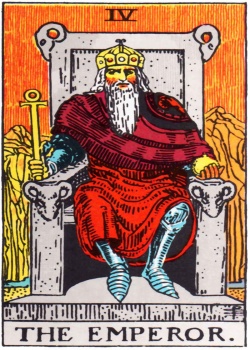The Emperor: Difference between revisions
| Line 31: | Line 31: | ||
"In readings the Emperor indicates (following the Rider pack image) the power of society, its laws and especially its authority to enforce those laws."<Ref>Pollack, Rachel. Seventy-Eight Degrees of Wisdom. Harper Collins, 1980. p. 52.</ref> | "In readings the Emperor indicates (following the Rider pack image) the power of society, its laws and especially its authority to enforce those laws."<Ref>Pollack, Rachel. Seventy-Eight Degrees of Wisdom. Harper Collins, 1980. p. 52.</ref> | ||
"The card represents active yang force. The Emperor is the domination of the mind over the heart. Structure and regulation are pertinent themes."<ref>Wen, Benebell. Holistic Tarot: An Integrative Approach to Using Tarot for Personal Growth. Berkeley, CA: North Atlantic Books, 2015.</ref> | |||
===Recovery=== | |||
"Traditionally, if the card appears in a man’s reading, it indicates self-mastery and virile power, and in a woman’s, a father figure. The modern, more gender-neutral approach is to interpret it as dominance and superiority in the work, career, and business realms. When the Emperor card appears, themes of order, authority, and jurisdiction will be at play."<ref>Wen, Benebell. Holistic Tarot: An Integrative Approach to Using Tarot for Personal Growth. Berkeley, CA: North Atlantic Books, 2015.</ref> | |||
{{endstuff}} | {{endstuff}} | ||
Revision as of 20:11, 12 July 2020
The Empress is an Old Energy Archetype from the Masonic Tarot Deck. In the Book of Slavery, the archetype is typically used to enforce gender stereotypes. In the Book of Power, it is used to instruct on the power Formation, archetypes, and ideas.
List of Old Energy Archetypes from the Masonic Tarot
Chariot, Death (archetype), Duality, Hermit, Hierophant, High Priestess, Judgement, Justice, Star, Strength, Sun (archetype), Temperance, The Devil, The Emperor, The Empress, The Fool, The Hanged Man, The Lovers, The Magician, The Moon, The Tower, The Wheel of Fortune, The World (old energy)
Related Terms
Old Energy Archetypes > Book of Slavery
Notes
Book of Power
BOP: "From the ethereal heights of the ideal, the constructive aspirant is thrown headlong into the land of action. (The test of the first symbolic journey.) It is the battlefield of life. Here swords cross. But the aspiring Initiate does not involve himself in the pointless battles of opinions and sides: he reserves his energy in order to be able to apply it in the shaping of the 'Cubic Stone'."[1]
The Emperor suggests "rulership." [2]
Book of Slavery
Association of the masculine "principles": with divine authority. "The helmet indicates the rule of the Divine Will in the Universe, and its universal action in the creation of Life (eagle)."[3]
Also law and order. Law versus chaos. "Any other approach can only destroy society. Today, we see this viewpoint embodied in an abstraction we call the 'system' . The Romans saw it more concretely in the personal figure of the Emperor, whom they described as the father of all his people."[4]
Active/Yang/Positive/Masculine reinforcement of stereotypes: "The man indicates the active; his position, however, shows that this activity is engendered by a superior term. The 1st arcanum, the Juggler, the active absolute, was represented standing, looking to the front; the 4th arcanum, active relative, is seated in profile." [5]
"Trumps 3 and 4 of the Tarot represent the parents in their archetypal roles. But just as the Empress signified the natural world, so the Emperor carries the wider significance of the social world 'married' to nature. He symbolizes the laws of society, both good and bad, and the power that enforces them."[6]
"In readings the Emperor indicates (following the Rider pack image) the power of society, its laws and especially its authority to enforce those laws."[7]
"The card represents active yang force. The Emperor is the domination of the mind over the heart. Structure and regulation are pertinent themes."[8]
Recovery
"Traditionally, if the card appears in a man’s reading, it indicates self-mastery and virile power, and in a woman’s, a father figure. The modern, more gender-neutral approach is to interpret it as dominance and superiority in the work, career, and business realms. When the Emperor card appears, themes of order, authority, and jurisdiction will be at play."[9]
Footnotes
- ↑ Oswald Wirth, Tarot of the Magicians: The Occult Symbols of the Major Arcana That Inspired Modern Tarot (San Francisco. CA: Weiser Books, 1990).
- ↑ Case, Paul Foster. An Introduction to the Study of the Tarot. New York: Kindle Edition, 1920. p. 27.
- ↑ Papus, The Tarot of the Bohemians (Wilshire Book Co, 1978), https://sacred-texts.com/tarot/tob/index.htm.
- ↑ Pollack, Rachel. Seventy-Eight Degrees of Wisdom. Harper Collins, 1980. p. 50.
- ↑ Papus, The Tarot of the Bohemians (Wilshire Book Co, 1978), https://sacred-texts.com/tarot/tob/index.htm.
- ↑ Pollack, Rachel. Seventy-Eight Degrees of Wisdom. Harper Collins, 1980. p. 49.
- ↑ Pollack, Rachel. Seventy-Eight Degrees of Wisdom. Harper Collins, 1980. p. 52.
- ↑ Wen, Benebell. Holistic Tarot: An Integrative Approach to Using Tarot for Personal Growth. Berkeley, CA: North Atlantic Books, 2015.
- ↑ Wen, Benebell. Holistic Tarot: An Integrative Approach to Using Tarot for Personal Growth. Berkeley, CA: North Atlantic Books, 2015.
{{#seo: |author="Mike Sosteric" |title=Tarot Card Meanings Old Energy |title_mode=append |keywords=tarot, freemasons, freemasonry |site_name=The SpiritWiki |description=The Old Energy Masonic Meanings of The Emperor }}
